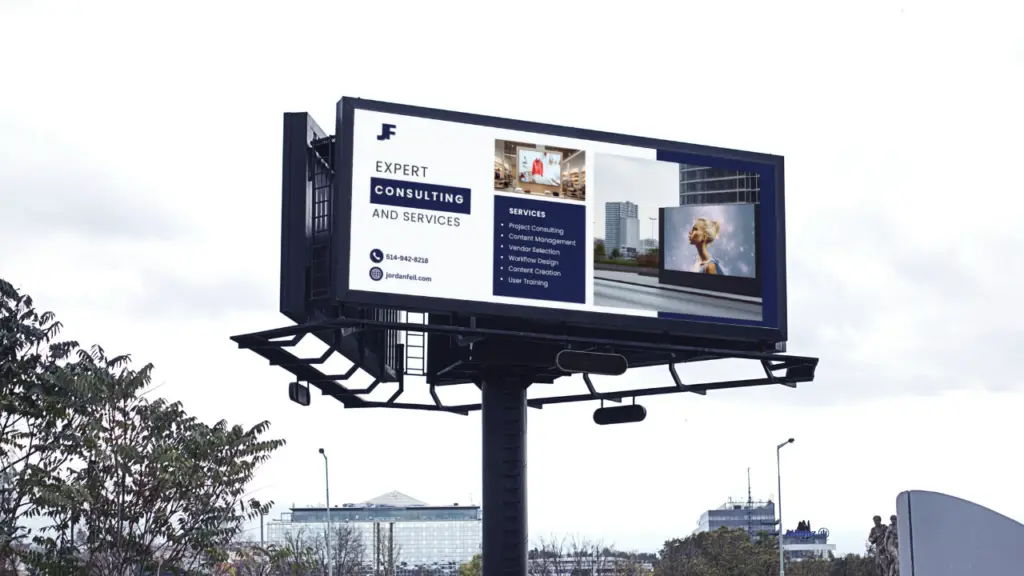If you still believe DOOH advertising just means fancy digital billboards with perfume ads in malls, you’re missing a critical opportunity.
Digital Out of Home (DOOH) advertising is transforming how brands connect with audiences in public spaces. This comprehensive guide covers everything you need to know about DOOH digital signage in 2025, from basic concepts to advanced strategies.
What is DOOH Advertising?
Digital Out-of-Home (DOOH) advertising is a modern way to reach people with digital screens in public spaces. Think malls, airports, highways, and train stations. Unlike old-school billboards, DOOH lets advertisers serve dynamic content that can change based on time, weather, location, or even audience data.
What Makes DOOH Different from Traditional Billboards?
-
Digital, not static: It uses digital screens instead of paper or vinyl posters.
-
Remote content control: No need to climb a ladder to change the message. It’s all updated online.
-
More ads, same screen: One screen can show different ads in rotation.
-
Smarter targeting: Ads can change based on real-time data, like traffic flow or weather.
-
Interactive features: Some DOOH screens respond to gestures, QR scans, or touch, boosting audience engagement.
Key Benefits of DOOH Advertising
1. Contextual Relevance: Right Message, Right Moment
One of DOOH’s superpowers is its ability to serve content that matches the time, place, and audience mood.
-
Weather-responsive ads: Serve up cold drink promos when the temperature spikes.
-
Time-specific messaging: Push breakfast menus in the early morning, and happy hour specials later in the day.
-
Geotargeted content: Promote in-store offers only when a screen is near the actual location.
✅ Takeaway: This level of contextual targeting helps boost recall, engagement, and conversion. Without wasting impressions.
2. Dynamic Creative That Captures Attention
Static billboards can’t hold a candle to the flexibility of dynamic digital signage.
-
Update messaging across entire networks instantly
-
Use animation and motion to stand out in crowded environments
-
Rotate creatives based on triggers like traffic flow or dayparting
-
Run A/B creative tests in real time to see what works best
✅ Takeaway: Better visuals + smart automation = more impact, less guesswork.
3. Smarter Audience Targeting, Built for Scale
Today’s DOOH platforms can zero in on the right viewers using real-world data.
-
Detect crowd density using mobile device signals
-
Analyze foot traffic patterns for peak targeting windows
-
Leverage demographic data of location visitors
-
Integrate first-party data for omnichannel synergy
✅ Takeaway: Think of it as location-based advertising that’s just as data-driven as your digital retargeting.
4. Real-Time Flexibility for Agile Campaigns
Marketing conditions change fast. DOOH lets you keep up.
-
Push emergency alerts across screens within minutes
-
Optimize or pause underperforming creative on the fly
-
Update promos without waiting on print or production
-
Respond to breaking news, supply chain changes, or weather shifts
✅ Takeaway: Real-time content optimization isn’t a nice-to-have, it’s a necessity.
Bottom Line:
DOOH blends the targeting power of digital with the scale and presence of traditional out-of-home media. It’s flexible, measurable, and designed for the speed of today’s consumer behavior.

Types of DOOH Advertising Formats
Digital Out-of-Home (DOOH) advertising isn’t just one-size-fits-all. It spans a wide range of formats. Each tailored for different environments, audience behaviors, and campaign goals. Let’s break it down.
1. Digital Billboards
Big, bold, and built for reach.
These are the massive displays you see along highways or busy city roads.
-
Typical size: 14′ x 48′ up to 20′ x 60′
-
Visible from over 500 feet away
-
Ads rotate every 8–10 seconds
-
Great for high-traffic, high-impact branding
-
Ideal for mass awareness at scale
Best use case: Broad-reach campaigns, product launches, political ads, and brand awareness blitzes.
2. Street Furniture
DOOH meets the urban landscape.
These are smaller screens embedded in everyday city infrastructure.
-
Found in:
-
Bus shelters
-
Public benches
-
Info kiosks
-
Charging stations
-
WiFi hotspots
-
-
Up close and personal: Great for pedestrian traffic
-
Often geo-targeted for hyperlocal relevance
Best use case: Neighborhood-level targeting, city tourism campaigns, or local business promotions.
3. Transit Displays
Mobile audiences, meet mobile screens.
Transit-based DOOH reaches people when they’re on the move.
-
Seen in:
-
Airport terminals
-
Train platforms
-
Inside buses and subways
-
Taxis and rideshares
-
Ferries and cruise ships
-
-
Captive audiences = high dwell time
-
Useful for travel-related messaging or brand storytelling
Best use case: Travel brands, event promotions, and any advertiser wanting attention during long commutes.
4. Place-Based Networks
Screens exactly where your audience is.
These displays live in venues people choose to spend time in.
-
Typical locations:
-
Doctor’s offices and clinics
-
Gyms and fitness centers
-
Restaurants and bars
-
Highly targeted with contextual relevance
-
Often paired with interactivity or QR codes
Best use case: Contextual promotions (e.g. protein shakes at gyms, skincare at med spas), loyalty programs, or upsell offers.
Choosing the Right DOOH Format
Each format has unique strengths when it comes to audience engagement, location targeting, and cost structure. The most successful campaigns mix and match formats based on:
-
Target audience behavior
-
Message complexity
-
Budget and duration
-
Environment and context
Want help building a multi-format DOOH strategy that actually converts? I can help with that too.

The Growth of DOOH: Current Market Statistics
Digital Out-of-Home (DOOH) advertising isn’t just growing, it’s exploding. As of 2025, the numbers tell a story of transformation, scale, and serious advertiser confidence.
🚀 Key Stats Driving the DOOH Boom:
-
$35.6 billion in global DOOH ad spend in 2024. An 18% year-over-year jump
-
DOOH now accounts for 42% of all out-of-home (OOH) ad spending
-
35% of static OOH assets have been converted to digital formats
-
The average consumer now sees DOOH for 17 minutes a day
-
67% of media buyers increased their DOOH budgets in 2025
Why the Growth? A Few (Not-So-Secret) Reasons:
-
Expanded digital inventory: More screens in more places. Urban, suburban, and even rural.
-
Smarter ad tech: Programmatic buying, AI targeting, and real-time content make DOOH more relevant than ever.
-
Better measurement: Location data, impression validation, and audience analytics have built advertiser trust.
-
Higher engagement: With more eyeballs on screens and more time spent viewing, DOOH is driving results.
Advertisers aren’t just testing DOOH, they’re scaling it. And consumers are noticing.
Need Help With Your DOOH?
Getting Started with DOOH Advertising
Here’s a Step-by-Step Guide to Get It Right
Digital Out-of-Home (DOOH) advertising offers incredible reach and flexibility, but to make it work, you need a smart plan. Whether you’re going for brand lift, foot traffic, or real-time engagement, here’s how to build and launch a DOOH campaign that delivers results:
✅ 1. Define Your Campaign Objectives
What are you trying to achieve?
Start with a clear goal. Is it brand awareness, driving in-store visits, promoting an event, or capturing leads? Your objective will shape every other decision.
🎯 2. Know Your Audience
Who needs to see your message?
Pin down your target demographics, behavior patterns, and daily routines. This will guide where, when, and how you reach them in the real world.
📍 3. Choose the Right DOOH Formats
Pick screens that align with your goals.
Need broad reach? Go with digital billboards. Want to influence in-store decisions? Try retail or transit displays. Match format to intent.
🎨 4. Design Creative That Fits the Medium
Tailor your content for DOOH screens.
Keep your message short, bold, and easy to absorb in seconds. Use high contrast, large fonts, and motion to stand out.
💰 5. Select Your Buying Method
How will you purchase media?
Go direct for long-term placements, programmatic for dynamic reach, or hybrid to balance flexibility with control. Consider your budget and timeline.
📊 6. Plan for Measurement
How will you track success?
Set up clear KPIs like impressions, dwell time, foot traffic, or conversions. Make sure your tech stack can track them across channels.
🔁 7. Launch and Optimize
Get live, then improve in real time.
Once the campaign is running, monitor performance regularly. Use audience data, creative tests, and location insights to tweak and scale what’s working.
Final Tip:
DOOH isn’t just about being seen, it’s about being seen by the right people, in the right place, with the right message. Plan smart, execute clean, and keep optimizing.
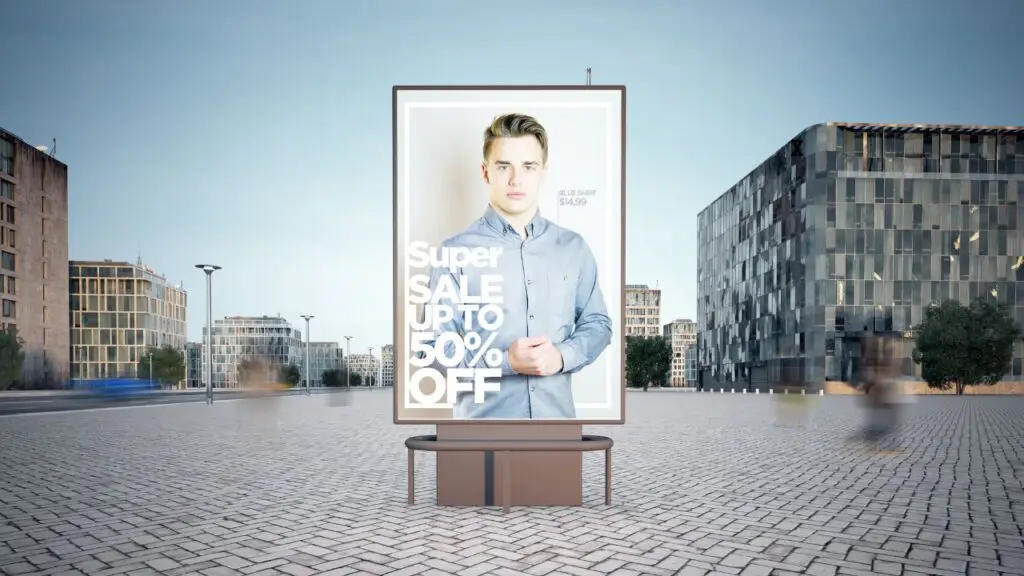
DOOH Technology Advancements in 2025
The tech behind Digital Out-of-Home (DOOH) advertising isn’t just evolving, it’s accelerating. In 2025, advances in display resolution, smart sensors, and energy efficiency are making DOOH more intelligent, more impactful, and more sustainable than ever before.
Higher Resolution Displays
Visuals that demand attention, day or night.
Today’s DOOH screens are delivering stunning clarity and performance:
-
8K resolution is now the standard on premium digital billboards
-
Micro-LED displays offer better brightness and visibility in full daylight
-
98% color accuracy ensures brand consistency across campaigns
-
178-degree viewing angles make content visible from almost any direction
The result? Sharper creative, better visibility, and stronger viewer engagement. No matter the location.
Smart Sensors & IoT Integration
Smarter screens that react in real time.
Modern DOOH isn’t just a screen, it’s a data hub that responds to its environment:
-
Tracks impressions with anonymous audience measurement systems
-
Adjusts content based on environmental conditions (like weather or lighting)
-
Uses vehicle speed detection to adapt highway billboard messaging
-
Integrates air quality and temperature sensors for hyper-relevant creative
The result? Content that’s not just seen, it’s contextually relevant, personalized, and data-optimized.
Energy Efficiency & Sustainability
A greener future for outdoor advertising.
As environmental pressure grows, DOOH is becoming more sustainable by design:
-
Solar-powered units reduce reliance on grid electricity by up to 65%
-
Smart dimming tech lowers screen brightness based on ambient light
-
Next-gen LEDs cut power consumption by up to 40%
-
Carbon offset programs are now standard across leading DOOH networks
The result? Lower energy costs, better alignment with ESG goals, and a significantly reduced carbon footprint.
Bottom Line:
DOOH technology in 2025 isn’t just better, it’s more responsive, more efficient, and more responsible. That’s good news for advertisers, audiences, and the planet.

Programmatic DOOH: Smarter Buying for Smarter Screens
Programmatic buying has transformed Digital Out-of-Home (DOOH) advertising. By bringing automation, data-driven targeting, and real-time optimization to physical screens, it enables faster execution, better performance, and more efficient media buying.
How Programmatic DOOH Works
The programmatic process automates campaign deployment through these key steps:
-
Advertiser sets campaign parameters (budget, audience, timing)
-
DSP (Demand-Side Platform) evaluates available inventory
-
Real-time bidding occurs for available screen time
-
Winning creative is displayed on selected screens
-
Performance data is collected and analyzed
-
Campaign optimizes based on results
This streamlined approach allows marketers to launch agile, data-driven DOOH campaigns with the precision and flexibility of digital media.
2025 Programmatic DOOH Innovations
Recent advancements have significantly expanded the capabilities of programmatic DOOH:
-
Supply-side unification enables seamless cross-network campaign execution
-
Micro-bidding allows advertisers to purchase screen time in increments as short as five seconds
-
Dynamic creative optimization adjusts messaging in real time based on conditions like weather or audience density
-
Enhanced inventory discovery tools improve screen selection through advanced filtering
-
AI-powered audience forecasting delivers up to 87 percent accuracy in predictive targeting
Together, these innovations improve targeting precision, boost campaign agility, and allow for broader, more effective reach across diverse environments.
Programmatic DOOH Pricing Models
Programmatic buying also opens the door to flexible pricing structures that fit a range of campaign goals:
-
CPM (Cost Per Thousand Impressions)
-
CPDV (Cost Per Digital Viewing)
-
dCPM (Dynamic Cost Per Thousand)
-
Share of Voice arrangements
-
Hybrid guaranteed and auction-based models
These options give advertisers the ability to scale intelligently, prioritize visibility, and align budget with performance expectations.
Programmatic DOOH gives brands the tools to reach the right audience, at the right time, on the right screens. All with measurable results and dynamic control. It’s not just the future of OOH. It’s happening now.
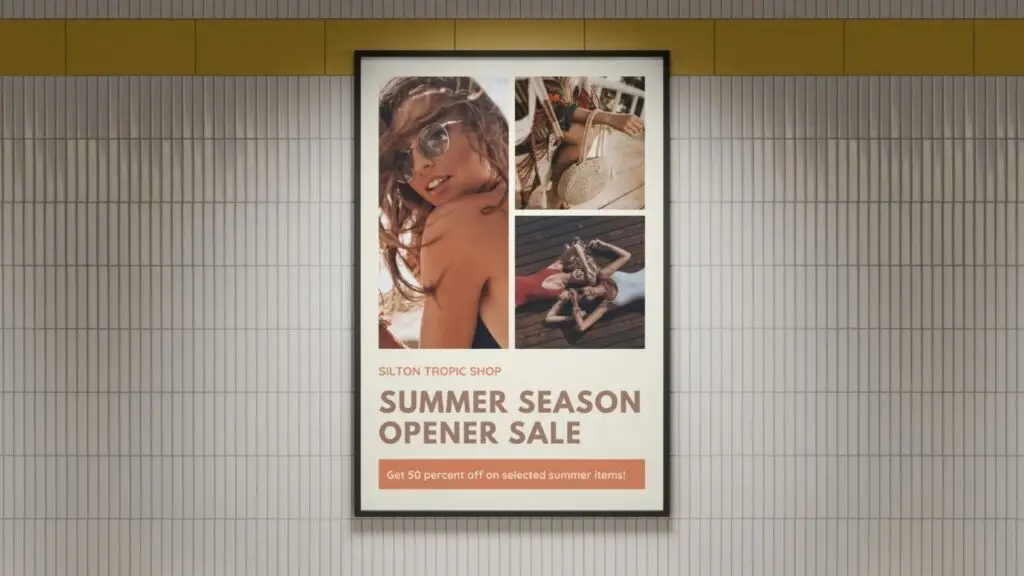
Looking For Affordable Guidance?
Current Industry Benchmarks and Statistics
Performance expectations for DOOH have evolved in 2025:
- Average attention time for DOOH ads: 2.5 seconds
- Recall rates for programmatic DOOH: 43% (up from 38% in 2023)
- Click-through rates on mobile retargeting after DOOH exposure: 0.72%
- Store visit lift from targeted DOOH campaigns: 21%
- Brand awareness increase from integrated DOOH/digital campaigns: 36%
What’s Next for DOOH?
Emerging Trends That Will Define the Future
Digital Out-of-Home (DOOH) is entering a new era, one driven by real-time intelligence, advanced interaction, and smarter personalization. Here’s what’s on the horizon:
1. Hyper-Contextual Advertising
Content that reacts to the environment in real time.
The next generation of DOOH will go far beyond time-of-day targeting. Screens will soon be responsive to the sights, sounds, and rhythms of their surroundings:
-
Displays that react to ambient sound levels, increasing visual intensity in noisy urban areas
-
Adjusting content speed based on pedestrian flow. Slower for relaxed areas, quicker for fast-paced zones
-
Urban pulse tracking, aligning creative pacing with real-time city data (traffic, footfall, local moods)
-
Synchronization with local events, triggering relevant content during concerts, sports games, or festivals
Bottom line: Ads will feel less like ads and more like part of the environment.
2. Advanced Interactive Experiences
Beyond touchscreens: smarter, safer, more intuitive engagement.
Interactivity in DOOH is moving well past tapping on a screen. The next frontier is contactless, intuitive, and multi-user:
-
Gesture-based control systems. Perfect for hygiene-conscious or high-traffic environments
-
Voice-activated interfaces for hands-free engagement
-
Displays that adapt based on biometric signals (e.g., dwell time, eye movement)
-
Multi-user experiences that engage several people at once with split-screen or layered content
The goal: make every screen a conversation, not just a broadcast.
3. Personalization at Scale
Custom content, delivered ethically and anonymously.
The challenge: how to personalize without invading privacy. The solution? Smarter segmentation and opt-in tech:
-
Anonymous clustering of viewers into audience groups based on behavior
-
Privacy-compliant facial analysis for age and emotion estimation, no data stored
-
Opt-in personalization via mobile device sync (Bluetooth, QR code, or app connection)
-
Cohort-based creative rotation. Different content for groups based on interests or context
Personal, not invasive. Relevance without compromise.
The Future Is Responsive
As DOOH becomes more intelligent, it won’t just reach audiences, it will adapt to them. The brands that embrace this responsive, respectful, and real-time model will be the ones that stand out on the streets of tomorrow.
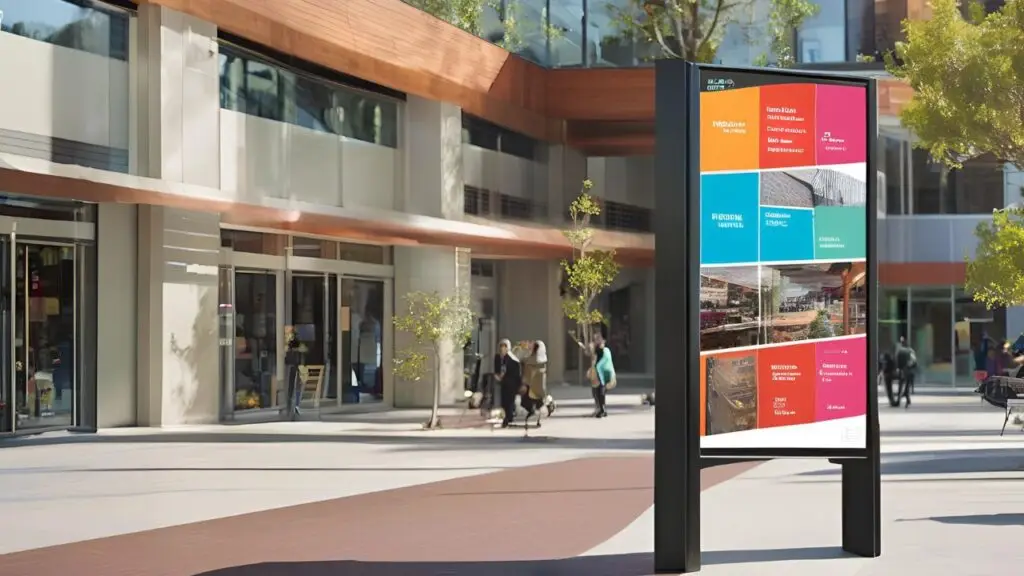
Work with a DOOH Expert
Need guidance on your DOOH strategy? With 16+ years of experience in digital signage and DOOH media, I provide expert consulting to help brands maximize their out-of-home impact.
Contact me to discuss how DOOH can fit into your marketing strategy, from media planning to creative optimization and performance measurement.
Learn more in my complete DOOH Advertising insights archive.
FAQ
What is DOOH advertising?
DOOH (Digital Out-of-Home) advertising uses digital screens in public spaces to deliver dynamic, targeted content to audiences. Unlike traditional billboards, DOOH can display changing content, videos, and interactive experiences that adapt to real-time conditions.
What is the difference between traditional Out-of-Home (OOH) advertising and Digital Out-of-Home (DOOH) advertising?
Traditional Out-of-Home (OOH) advertising uses static printed materials like billboards and posters with fixed content throughout a campaign. DOOH uses digital screens to display content that can change instantly based on factors like time, weather, audience, or events, offering greater flexibility, targeting capabilities, and measurement options.
How does programmatic DOOH work?
Programmatic DOOH automates the buying, placement, and optimization of advertisements on digital screens. It uses real-time bidding platforms to purchase screen time based on audience targeting parameters, contextual factors, and performance goals. The system can automatically adjust creative content, timing, and placement to maximize effectiveness based on conditions like weather, traffic patterns, or nearby events.
